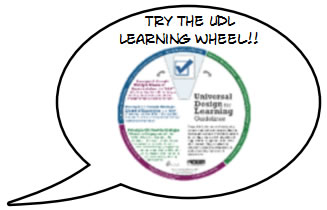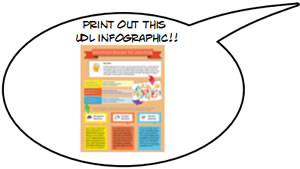
Universal Design for Learning
"Within a period of 10 years, UDL has captured the imagination of policy makers, researchers, administrators, and teachers. The mantra that evolved from our understanding of the value of curb cuts and the like, “good design for people with disabilities benefits everyone,” provides a powerful rationale for exploring the large-scale application of UDL in education."
Edyburn, Dave L. . "Would you Recognize Universal Design for Learning if you
saw it? Ten Propositions for New Directions for the Second Decade of UDL."
Learning Disability Quarterly 33 1 (1 January 2010): pp. 33-39.
Universal Design for Learning (UDL) is a discipline that aims to provide access to learning for all students. UDL has its roots in universal design in architecture. Just as spaces can provide or deny access (think stairs versus ramps, door knobs versus door handles), learning environments can provide or deny access to learning.
UDL understands "disability" as a construct defined by the relationship between an individual and the environment. As such, altering the environment can disable or enable student learning. In addition, UDL has gained acceptance in recent years partly because of recent advances in brain research that show the learning process in the brain in greater detail. As a result, we understand more about the brain's recognition, affective, and strategic networks. In general, we now understand that all students benefit from varied opportunities to comprehend, engage in, and express their understanding.
In this way, UDL highlights the synergy between general and special education. While UDL is a principle for teaching allstudents, increasing access to learning for all lowers the barriers for those who might otherwise be classified as having special needs. At the same time, understanding the assistive technology needs of special education students helps us consider options that might benefit others.
The three guiding principles for implementing Universal Design for Learning parallel the recognition, strategic, and affective networks in the brain. These networks address, respectively, the "what," how," and "why" of learning.
Principle #1: ― The "What" – Provide multiple means of representation to access information and concepts. This principle concerns how we  gather facts and categorize what we see, hear, and read. Examples are: multimedia, manipulatives, larger type, books on tape, and books at different levels.
gather facts and categorize what we see, hear, and read. Examples are: multimedia, manipulatives, larger type, books on tape, and books at different levels.
Principle #2: ―The "How" – Provide multiple means of action and expression. This principle concerns how we organize and express our ideas. Writing an essay or solving a math problem are strategic tasks. Examples are: handwriting an assignment, using speech-to-text or word prediction writing tools, and creating multimedia work.
Principle #3: ―The "Why" – Provide multiple means of engagement in learning. This principle concerns how learners engage with, and understand the relevance of, their learning. Examples are: connecting content to one's own experience, using games and simulations, and engaging in inquiry.
Visit our Web Resources page for links on UDL. You can also view more at CAST's YouTube channel or at the National Center for Universal Design
Try the new UDL Learning Wheel!
for Learning'sVideos About UDL:

